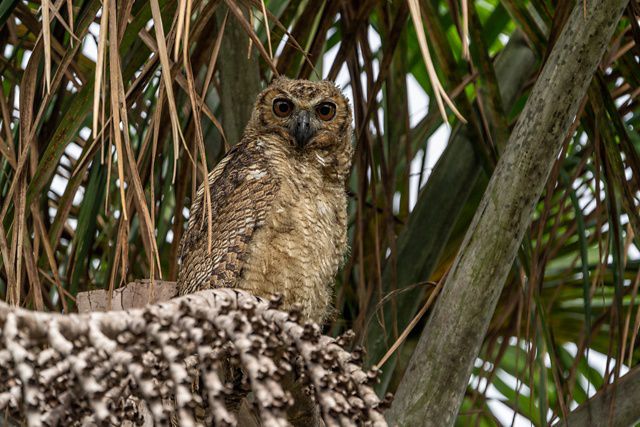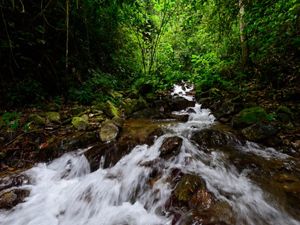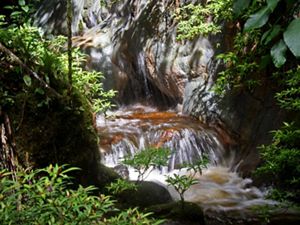A New National Park is Born in Colombia
The newly created National Natural Park Serranía de Manacacías, safeguards a vital wildlife corridor and a globally important ecosystem that was not represented in the protected area system.
National Natural Park Serranía de Manacacías became Colombia’s 61th national protected area. The new park spans 168,476 acres (68,180 hectares), an area nearly four times the size of Washington D.C., and safeguards an essential wildlife corridor that connects the Orinoquia, the second largest tropical savanna in the continent, and the Amazon, the largest river basin and rainforest on Earth.
The area includes six unique ecosystems that were not previously represented in the National Protected Area System and are home to unparalleled biodiversity, including a quarter of all the bird species known to live in Colombia.
“Manacacías has twice as many bird species as any other river basin in the Orinoquia,” said Tomas Walschburger, The Nature Conservancy (TNC) Colombia’s senior scientist, noting that Colombia boasts the longest bird list of any country and ranks second in butterfly diversity, with two new species discovered in Manacacías recently.

In fact, Colombia is the second most biodiverse country in the world, home to an estimated 10% of the planet’s biodiversity. As such, it plays a vital role in the conservation efforts established to meet the global goal of protecting and conserving at least 30% of the planet’s land, sea and freshwater habitats by the year 2030, commonly referred to as “30x30.” The creation of the country’s 61st national park is a critical step toward meeting this target and demonstrates how nations can act on their global commitments to biodiversity protection.
TNC is proud to support the formal protection of this incredibly biodiverse area in partnership with Colombia's National Parks Agency (PNN), the Institute of Investigation of Biological Resources Alexander von Humboldt, the Institute of Natural Sciences of the National University of Colombia, WCS Colombia, WWF, the Corporation for the Sustainable Development of the La Macarena Special Management Area (Cormacarena), and the Alliance for the Conservation of Biodiversity, Territory and Culture.
Thanks to the support of the Wyss Foundation and Art into Acres through Re:wild, TNC supported the Government of Colombia with the creation of the new park in this incredibly diverse and globally important ecosystem, while safeguarding the Orinoquia culture.
“I want to thank the Colombian government, its leaders, and the people of Colombia for championing and preserving biodiversity within your nation’s borders and across the globe. This announcement shows how seriously Colombia’s leaders are taking their commitment to help protect 30% of the Earth’s surface by 2030—the minimum scientists say we need to protect biodiversity and fight wildlife extinctions. The newly protected Manacacías National Park is now a jewel of Colombia’s national parks system, safeguarding an incredibly biodiverse savanna grassland that’s under-represented among protected areas anywhere else on Earth.”
Hansjörg Wyss, founder of the Wyss Foundation and Campaign for Nature.
"This is a project of scientific integrity that conserves both the surface and subsurface of a unique ecosystem of the Llanos biome that had not been protected before on Earth. I appreciate the methodical and conservative work done by the government and the National Parks service and am grateful to TNC, Re:wild, Helena Gutierrez from ESRI, and Enrique Ortiz from Andes Amazon Fund for their support in our due diligence throughout this conservation process. Our time spent in Manacacías and discussions with the community members and the Minister of the Environment throughout this declaration process displayed a consistent commitment to nature”
Haley Mellin, artist and founder of Art into Acres
The declaration of this new national natural park is not only a commitment to the protection of Colombia’s natural heritage, but also to addressing the triple connected crises of climate change, biodiversity loss, and human wellbeing. As a native Colombian, I am proud to see the country protecting its unique and abundant biodiversity and taking the lead on a global stage in meeting the commitment to protect 30% of the planet by 2030.”
Dr. Lina Valencia, Andean countries coordinator for Re:wild, which provided support for the project.

“Establishing Serranía de Manacacías National Park is a critical step towards the conservation of Colombia’s magnificent natural heritage and a strategic step towards fulfilling our country’s commitment to the Conservation of Biological Diversity that calls for protecting 30% of our planet’s land, fresh water and oceans before 2030. The Nature Conservancy is proud to collaborate with the Colombian government on this endeavor.”
Claudia Vásquez, Director, TNC Colombia
A threatened frontier
An aerial view of Colombia’s savannas shows them as an enormous green ocean dotted with wetlands and small hillocks resembling waves. Thin water lines flow across the grasslands, eventually forming broad rivers that course between dense forests.
Birds, mammals and water flow across the savannas on their way to the Amazon jungle, binding these two massive ecoregions into a vibrant life support hub for Latin America and the planet.
Here, life moves with the ebbs and flows of the rivers that flood the plains during the rainy season and at the pace of cow herds that cross the savannas.
Traditional llaneros (Colombian cowboys) are the keepers of this landscape and a unique ranching culture characterized by acapella songs that reflect the close relationship between local communities, cattle, horses and nature. These work songs are passed through generations and were declared a UNESCO Intangible Cultural Heritage in 2017. Llaneros have skillfully used and conserved the grasslands over the last 200 years. It is not unusual to see livestock and wildlife grazing side by side. But today this landscape—and way of life—are changing rapidly.
Colombia's protracted armed conflict had mostly kept the area off-limits to large-scale development during the country's 50 years of civil unrest. With the signing of a peace agreement in 2016, the Orinoquia has become increasingly attractive to large-scale industrial agriculture, with an ever-growing expansion of oil palm and invasive eucalyptus plantations.

Each year, an area two-thirds the size of Yosemite National Park—500,000 acres—is transformed into agriculture and energy developments in the Orinoquia.
TNC’s scientists have warned that if agricultural expansion persists at its current rate, people and businesses could see a 40% reduction in water availability in most rivers in the region in less than 20 years.
However, Serranía de Manacacías has remained untouched by large-scale industrial development. Land use in this sparsely populated area has been primarily small-scale cattle ranching and low-input farming.
In a world of finite land and infinite demands for development, Manacacías offered a rare opportunity to protect an iconic landscape that is essential to wildlife and contains key natural ecosystems that are in good condition but imminently threatened.

Working together for enduring protection
Since the time Manacacías was included in Colombia's portfolio of priority areas for conservation seven years ago, TNC partnered with Colombia's National Parks Agency (PNN), World Wildlife Fund-Colombia, Wildlife Conservation Society and other organizations to support the formal protection of the area.
Creating the park has required enormous financial commitment and solid planning strategies, including securing the agreement among all stakeholders and orchestrating efforts with government agencies, landowners, donors, and non-governmental organizations.
It is worth noting that this is the first time the government of Colombia is purchasing land when declaring a protected area. TNC's vast experience in land transactions and solid reputation as a trusted broker and leader of multi-sector coalitions makes it uniquely positioned to help turn the vision of the park into a reality.
Beyond the protection of priority ecosystems, there must also be an emphasis on improving land practices on private lands surrounding the protected area with a focus on environmental, social and economic sustainability.
Since 2018, TNC has been working with landowners neighboring the new park to establish private reserves and promote sustainable productive practices. Our vision is a landscape where the protected area is linked to private reserves and foodscapes that improve ecological connectivity, climate resilience and food production, creating a sustainable future for the Orinoco grasslands and the unique culture they support.






